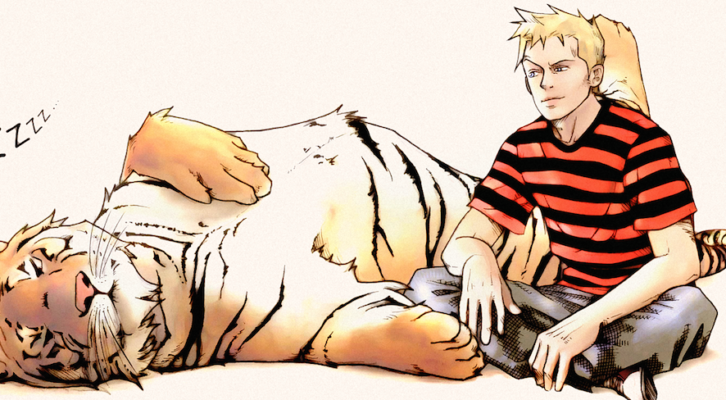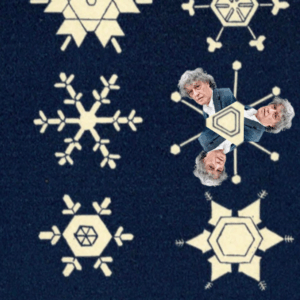
Why Calvin and Hobbes is Great Literature
On the Ontology of a Stuffed Tiger and Finding the Whole World in a Comic
“To an editor,” Bill Watterson, the creator of Calvin and Hobbes, wrote in 2001, “space may be money, but to a cartoonist, space is time. Space provides the tempo and rhythm of the strip.” Watterson was right, perhaps in more ways than he knew. Newspaper comics, he wrote, provide a unique space for many readers before they start their day; we get to pass, briefly, through a door into a calmer, simpler world, where the characters often remain largely the same, even down to their clothing. Not all newspaper comics are like this, of course, particularly the more complex narrative comics of the past like Little Nemo in Slumberland or Terry and the Pirates, and the worst comics—of which there are many—retain that sense of sameness by being formulaic and uninspired. But this, too, is related to space. Space, broadly speaking, is what defines Calvin and Hobbes.
The strip follows Calvin, a blonde six-year-old American that Watterson named after the founder of Calvinism. Calvin’s first appearance was actually in a rejected strip from before Calvin and Hobbes called Critturs, in which he is the younger brother of the main character; the syndicate suggested he focus on this sibling instead, and that led to the creation of his flagship comic. Often, Calvin’s imagination represents a more exciting, more marvelous vision of the world around him; instead of listening in class to Miss Wormwood (herself named for C. S. Lewis’s apprentice devil in The Screwtape Letters), he may be dreaming of fleeing from aliens in other galaxies. An only child, Calvin’s best friend is a tiger named Hobbes, himself named for the author of Leviathan. To everyone but Calvin, Hobbes appears to be a stuffed tiger, while Hobbes is a real, talking tiger to Calvin. In Watterson’s words, Hobbes’s true nature is never fully defined by the strip, which is one of its beauties; Hobbes is a kind of ontological marvel, and yet utterly mundane all the same, for he is whatever he needs to be for whomever is perceiving him.
Calvin and Hobbes feels so inventive because it is: the strips take us to new planets, to parodies of film noir, to the Cretaceous period, to encounters with aliens in American suburbs and bicycles coming to life and reality itself being revised into Cubist art. Calvin and Hobbes ponder whether or not life and art have any meaning—often while careening off the edge of a cliff on a wagon or sled. At times, the strip simply abandons panels or dialogue altogether, using black and white space and wordless narrative in fascinating ways. Like Alice, Calvin shrinks in one sequence, becoming tiny enough to transport himself on a passing house fly; in another, he grows larger than the planet itself. In “Nauseous Nocturne,” a poem in The Essential Calvin and Hobbes that reads faintly like a parody of Poe, Watterson treats us to lovely art and to absurd yet brilliant lines like “Oh, blood-red eyes and tentacles! / Throbbing, pulsing ventricles! Mucus-oozing pores and frightful claws! / Worse, in terms of outright scariness, / Are the suckers multifarious / That grab and force you in its mighty jaws”; the “disgusting aberration” “demonstrates defenestration” at the sight of Hobbes. In one gloriously profane strip, Calvin even becomes an ancient, vengeful god who attempts to sacrifice humanity. Nothing, except perhaps the beauty of imagination, is sacred here. Watterson dissolves the boundaries of highbrow and lowbrow art. The comic’s freedom is confined—it’s not totally random—yet the depths it can go to feel fathomless all the same. Few other strips allow themselves such vastness.
I’ve always loved the way that the best books—including comics—change as we do. The narrator of Borges’s “The Book of Sand” receives an inscrutable book from a bible-seller that literally changes every time he opens it, for it is impossible to find the same page twice; conversely, another of Borges’s protagonists, Funes the Memorious from the story of the same name, cannot forget anything he reads or perceives at all. Reality is somewhere in the middle of these extremes. Some books are palaces or grand multilayered structures like the etchings of Piranesi; we may only find secret doors and halls and rooms in them on our second or fourth reads, and there are some doors one reader may stumble upon that no one else ever will, including the writer of said text. “The days are just packed,” Calvin tells Hobbes in one of Watterson’s strips, in a line that would serve as the title for a collection. And so is the comic itself, which I’ve reread in its entirety many times, and yet I keep finding new little hidden rooms in it.
I’ve gotten more into comics as I’ve grown older, but Calvin and Hobbes is the one that has stayed with me from childhood to adulthood. Though focused on suburban American characters, it crossed cultural borders for me in Dominica because so much of it seemed universal. I lived at the edge of a mountain village, and on the days when the wind had stopped blowing and everything felt still and stricken with the melancholy of a too-short Sunday I enjoyed retreating into a room and disappearing into the world of a book collection of Calvin and Hobbes. (I had them all.) Then someone would call me through the halls of our house, or I would simply look up, and it was like waking from a trance. Suddenly, it would be evening, the wind up our mountain like the breaking of soft sea waves, the brown moths already crashing madly into the lamps or dying in the wax pool of a lit candle, the breadfruit leaves already like the silhouettes of monstrous bats in the dark, the night already having begun to put on her starry pearls. I loved disappearing into beloved books and reappearing into reality, with a shock, some hours later.
Later in my life, Calvin and Hobbes took on a new, unexpected shade of meaning. I was born two years after Watterson began the strip. At 27, I came out as a transgender woman and left my home in the Caribbean because I did not feel safe being openly trans there. Calvin and Hobbes is certainly not a text about queerness, yet when I returned to it at this altered point in my life, the strip suddenly seemed to describe things that resonated with me now: what it was like to live in a world where expressing your realest self is so often penalized, and the value of finding a second family, a close friend or friends, if your blood family fails to understand or accept the truest version of you. Calvin, I realized, could never fully be himself; the worlds he dreamt up were always lovelier and more marvelous than the dull world he was supposed to live in. It reminded me of the pressures I had felt to try to pretend to be what the largely anti-queer society I’d grown up in wanted me to be: straight, cis. And yet he, like me, had found a friend, Hobbes, outside of his blood family who understood him, and who allowed him to live out his dreams—an analogue for what those of us are queer and whose comings-out do not go so well will probably well understand. These are broad themes, but the strip contains them in abundance. Suddenly, the world of the comic seemed a little bigger, like its space in my heart.
*
Comics, if we define them at their broadest as sequential art, have been with us from the beginning, on the walls of caves, on the sides of pottery, and in how we translated the many languages of starry night skies into our own, simplifying the chaos of why-are-we-here into creations. And when we remove their words altogether, comics suddenly create a new potential for language: a universal form, a language without language that all may be able to understand, a rejection—and resurrection—of the Tower of Babel.
In their more modern form, the earliest comic, arguably, is from 1825, in the Glasgow Looking-Glass. In 1837, Rodolphe Topffer published The Adventures of Mr. Obadiah Oldbuck, which some critics consider the earliest comic book, and comics that offered social critiques and comedy became more common throughout the 19th century, like the anarchic Punch series or George Cruikshank’s political and satirical illustrations. A major milestone comes in 1895 with the publication of Richard Outcault’s Hogan’s Alley, which featured one of the first highly recognizable, recurring Sunday comic characters. Newspaper comics become much more popular in the early 20th century, and this was when, Watterson argues in The Calvin and Hobbes Tenth Anniversary Book, they were at their peak, as the space allotted to certain comics was far greater than that allotted to any modern newspaper comic. Without this great space, narrative, pictorially complex comics like Winsor McCay’s internationally influential Little Nemo in Slumberland would have been impossible, and the absurd, Kafka-meets-Surrealist world of comics like Herriman’s Krazy Kat would have been far more difficult to sell.
An oft-overlooked but critical development in the early 20th century is the wordless novel, a powerful yet short-lived genre that is essentially the proto-graphic novel. Wordless novels were just that: book-length narratives told without a single word, relayed entirely though images, which were woodblock cuts or wood engravings. They originated primarily with Frans Masereel in Germany and came to prominence in the United States with the landmark publication in 1929 of Lynd Ward’s incredible Gods’ Man: A Novel in Woodcuts. It is no coincidence they emerged at the same time that newspaper comics were at their peak and that silent cinema was also growing in popularity; the wordless novel, after all, was a kind of portable silent film. In Japan prior to the Great Kanto Earthquake of 1923, comics like McCay’s, as well as screenings of Western animated films, influenced the earliest Japanese animators. While not comics per se, it is clear that the comics had an influence upon these different forms of animation. Later comics like Arzach by the French artist Moebius continued the tradition of omitting words; Arzach, which was published in 1975, begins with dialogue, but is primarily composed of extraordinary wordless images, braided together by implied narrative. The graphic novel, the most critically popular form of comics today, stems out of all of these traditions.
Newspaper comics, at their best, are art and literature combined, but they, like cartoons in the Western world, still suffer the stigma of being “light” entertainment, with the one difference being that comics are “light” entertainment often aimed at adults as well as at kids. Of course, this view is wrong, both about cartoons and comics. Perhaps one reason, though, that the graphic novel (though not, to the same degree, manga) has broken more clearly into the realm of literary criticism is formal: the graphic novel is often packaged as a contained series, a single book containing an entire narrative—or, at least, a piece of a larger, continuing narrative. This, of course, makes graphic novels seem more akin to text-based novels or serialized narratives on the surface, and the fact that graphic novels have become so popular that single issues of comics are often assumed to be texts that will later be collected in larger volumes—in “novels”—means that the graphic novel generally possesses more space to tell its stories.
The newspaper comic, by contrast, as Watterson wrote in 1989 in the afterword to The Lazy Sunday Book, is in “retrograde evolution”; it is getting smaller and smaller, by and large, with less space to design complex narratives. The new space for invention—outside of graphic novels—is largely with webcomics, which can range from lazy to enormously inventive, the latter like Paul Duffield’s Firelight Isle. Newspaper comics may be collected in books, but, unlike graphic novels, they are rarely assumed to have a larger unifying narrative holding them together. This, perhaps, is one reason literary critics have been slower to adopt newspaper comics as items of study rather than graphic novels. Of course, there are also just many bad newspaper comics out there—and their badness, unsurprisingly, is often exacerbated by being forced into cramped spaces.
*
Watterson is well-remembered now for his refusal to license his characters for merchandise outside of the comics (with a few rare exceptions—calendars, collections in book form, a shirt for a special exhibit at the Museum of Modern Art, and a USPS stamp in 2010). Indeed, Watterson may be the name that comes to mind first nowadays when we bring up the idea of rejecting the merchandising of comic characters, though comic characters had been partnered with merchandising from the earliest days of Sunday strips with Hogan’s Alley, long before Watterson’s time. For Watterson, not licensing his characters to appear on merchandise meant preserving their integrity, as well as the comic’s.
After he ended the strip in 1995, Watterson largely disappeared from the public eye, only appearing briefly to give online interviews, write reviews of books of or about comics, and, very rarely, to contribute new pieces of art. Unexpectedly, in 2011, he painted the protagonist of Cul de Sac, one of the few modern strips he has publicly praised, and sent it to the comic’s creator. Ironically, Calvin and Hobbes have appeared all over the place since the strip ended, due to fans creating their own alternate comics, animations, and more; the lack of merchandising, perhaps, has driven fans to want more of the characters.
Almost 20 years after his own strip stopped, Watterson did three guest pieces for Stephan Pastis’s Pearls Before Swine. The second of these, to me, is the most telling. In it, a new artist, a second-grader girl named Libby, is drawing Pastis’s comic for him. A stand-in for Watterson, she thinks Pastis’s art is horrendous. She uses only two panels to jump from a standard scene of Pig and Rat talking to a sudden, brilliantly rendered Martian invasion, and Pastis tells her to “stop showing off”; slyly but accurately, she replies, “I could do better if I had more space.” This, perhaps, is the dilemma of newspaper comics in a nutshell.
*
“The art of losing’s not hard to master,” Elizabeth Bishop writes in “One Art,” a beautiful, devastating poem from 1979. Ruth Ozeki, in a lovely essay partly built around Bishop’s poem, notes astutely that what makes Bishop’s poem work is its use of the word loss rather than letting go. The difference between the two, Ozeki writes, is control: “When I let go, I’m in control; when I lose, I’m not. Letting go is a willful act; losing, a violation of my will.” Sometimes, of course, loss and letting go, violation and volition, coexist; sometimes, we lose when we think we are letting go, or we lose more than we had imagined when we release our hold. Watterson, in his fight over space and licensing and integrity, let go without believing he had really lost, and his characters, like Ozeki’s in A Tale for the Time Being, live on in the best and worst space of all: the nebulous space of memory, where borders constantly shift. Calvin and Hobbes endures as literature and art combined because it is both: it asks important questions without simplistically resolving them, revels in its own absurdities, and is filled with a deep understanding of people, of our swirling contradictions and complexities and conundrums. I love it as much in 2016 as I did two decades ago.
“Everything familiar has disappeared! The world looks brand-new!” Hobbes says in Watterson’s final strip, and, certainly, my own world after coming out seemed brand-new, as well. But after the pain and loss, sometimes we find more beauty in the world than we ever expected. It really can be a magical world, after all.
Featured art courtesy nami64.
Gabrielle Bellot
Gabrielle Bellot is a staff writer for Literary Hub. Her work has appeared in The New York Times, The Atlantic, The New York Review of Books, The New Yorker, The Paris Review Daily, The Cut, Tin House, The Guardian, Guernica, The Normal School, The Poetry Foundation, Lambda Literary, and many other places. She is working on her first collection of essays and a novel.



















